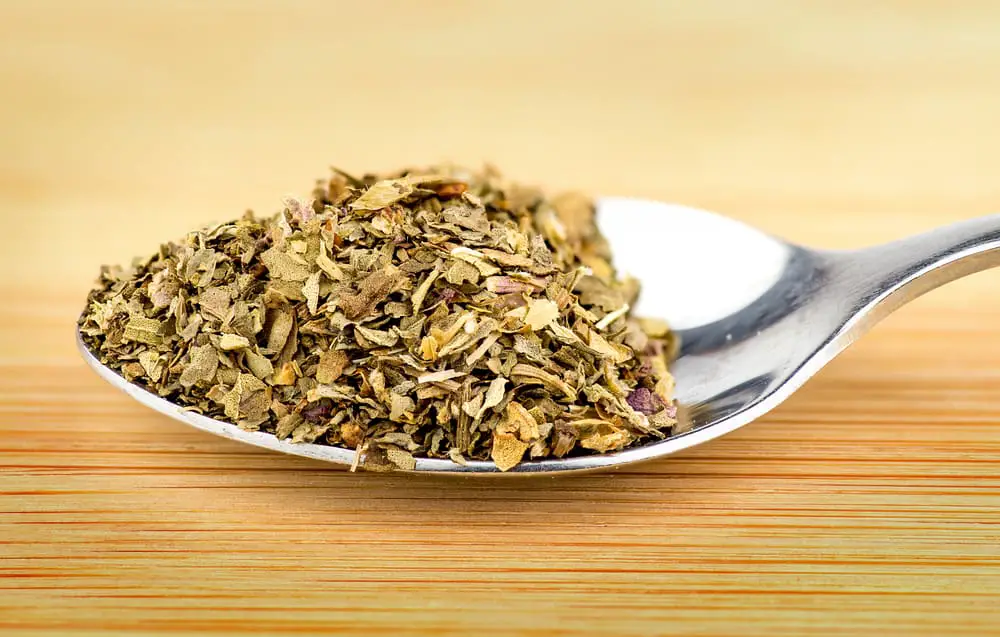Last Updated on 21st April 2022 by
Italian seasoning is a flavorful garnish for pizza, pasta, bread, soups, and many other dishes. While you can buy Italian seasoning prepackaged from the grocery, you could also make it at home, so long as you know what kind of seasonings go into it.
It’s not just rewarding to make your own seasoning; it can also save you some money, and it helps you keep control over what goes into it. You’ll know that there are no preservatives added, and you can keep it as natural and as safe as you like. You can also change up the ingredients to make it more to your liking, highlighting certain aspects of the seasoning mix more than others.
What Is Italian Seasoning?
It’s a mostly green, dry season used to flavor a variety of Italian dishes. It’s a basic blend of herbs that you could make easily if you have all the ingredients on hand, but you could also add to that, and you’ll find some gourmet Italian seasonings that go far beyond just the basic set of ingredients.
Italian seasoning can sometimes add extra ingredients and still be classified by the same name, but the classic blend tends to have a specific set of components. When you make it yourself, you’ll be able to play around with the amounts of all of those to make a personalized blend.
What Is in Italian Seasoning?
Most every Italian seasoning will contain all of the same spices, with some adding a few more. You’ll find that the majority of them have dried oregano, thyme, rosemary, marjoram, basil, and sage. How much of each of these is in there will vary from one seasoning mix to the next, so you may find an Italian seasoning blend that you prefer over another for that very reason.
You may not realize that it’s because there’s more of a certain herb than another. Some seasoning blends are prepared different ways, and the subtle differences can make certain Italian seasoning blends really stand out.
If you’re going to learn how to make Italian seasoning at home and make one that you and others enjoy, you’ll have to start with the basic ingredients. Learn how to mix them together in the right amounts to get the basic seasoning blend, and then you can play around with it from there.
Understanding what goes into the blend and what makes it work is the start of making something really special and unique that has your own personal touch to it.
How to Make Italian Seasoning
Now that you know what herbs are in Italian seasoning, let’s talk about the mixture you can put together to make it at home. Start with these dry ingredients:
- 1 teaspoon of dried thyme
- 1 teaspoon of dried marjoram
- 1/2 teaspoon of dried rosemary
- 1 1/2 teaspoons of dried oregano
- 1/2 teaspoon of dried sage
- 1/2 teaspoon of dried basil
So, to make your basic Italian seasoning mix, just mix all of these ingredients together in those amounts.
Storing Italian Seasoning
Once you’ve made your seasoning mix, how do you store it to make sure it lasts for a long time? You want to put it into an airtight bag or container and keep it in a cool dry place. If it gets too warm or if it gets damp at all, that’s going to really mess with the flavor of your seasoning and obliterate its shelf life.
Any Italian seasoning that you’re not using right away needs to be stored and kept sealed. You want to make sure it’s kept in an airtight container so that air doesn’t come in and oxygenate the seasoning. If air gets in, it will cause the herbs that make up the seasoning to lose their freshness.
Dried herbs and seasonings like these will last for years when stored properly.
Dried Italian seasoning should last for two to three years, as long as it’s kept in a cool dry place and doesn’t come into contact with water or a lot of sunlight. You also want to make sure that the container or package is kept tightly sealed when not in use.
Keep in mind that before you’ve mixed the ingredients together, they may have sat in their separate containers for a while, and you may not get the full two-to-three-year shelf life from your personal mix.
Variations on Italian Seasoning
Once you have the basic seasoning mix down and you’re happy with how it turned out and how it tastes, you may want to try adding a few things to it and see what that does to the flavor.
Some of the most common additions to classic Italian seasoning are onion powder and garlic powder. These can make it a lot more fragrant and flavorful, enhancing the taste and working very well as a dry rub for chicken, steaks, pork, and fish.
You can also try adding lemon pepper and black pepper to your seasoning to make a different kind of dry rub that has a little flair to it.
For a spicy Italian seasoning, try adding a little red pepper flake, ground chili powder, or cayenne pepper. This can be a good way to make a fragrant and flavorful Cajun seasoning for rice dishes, meats, and stir fries.
None of these added spices and herbs should affect the shelf life of your Italian seasoning. You may want to make these additions and changes in smaller batches and keep some homemade Italian seasoning on hand separately. You may not always want to use your modified Italian seasoning, and might want to be able to use regular Italian seasoning when a recipe calls for it.
There are tons of ways to use Italian seasoning, while it’s cheaper and easier to just buy it at the grocery already pre-made, there are advantages to making it yourself. You can add to it and modify it and make it just how you prefer, plus there’s the joy of simply making something yourself and then using it in your recipes.
I'm Pauline, a mother of four grown children, my passion for cooking stemmed from the joy i get cooking for my family. I love to try new dishes, especially when dining out but creating and sharing my own recipes is my favourite thing to do!


